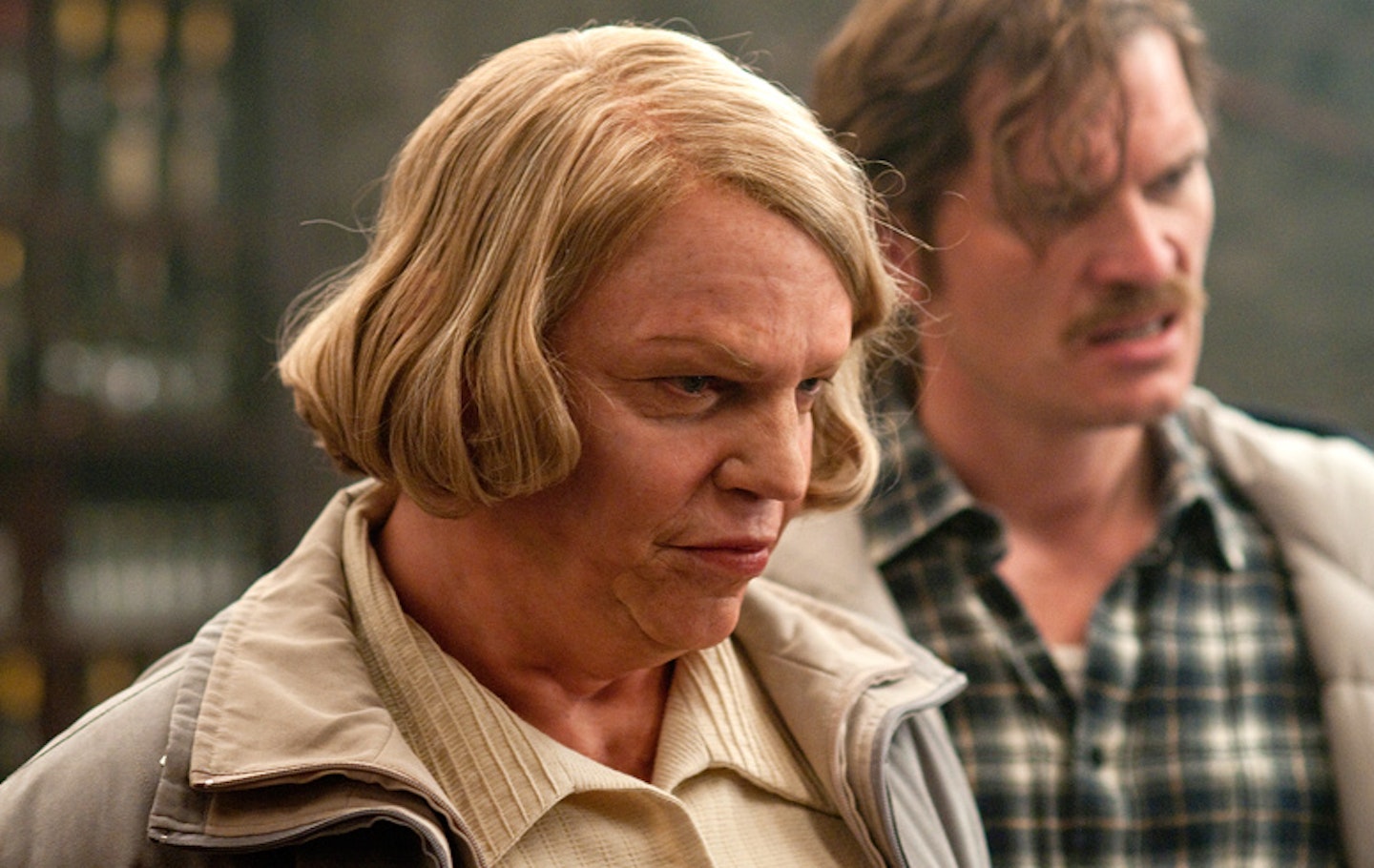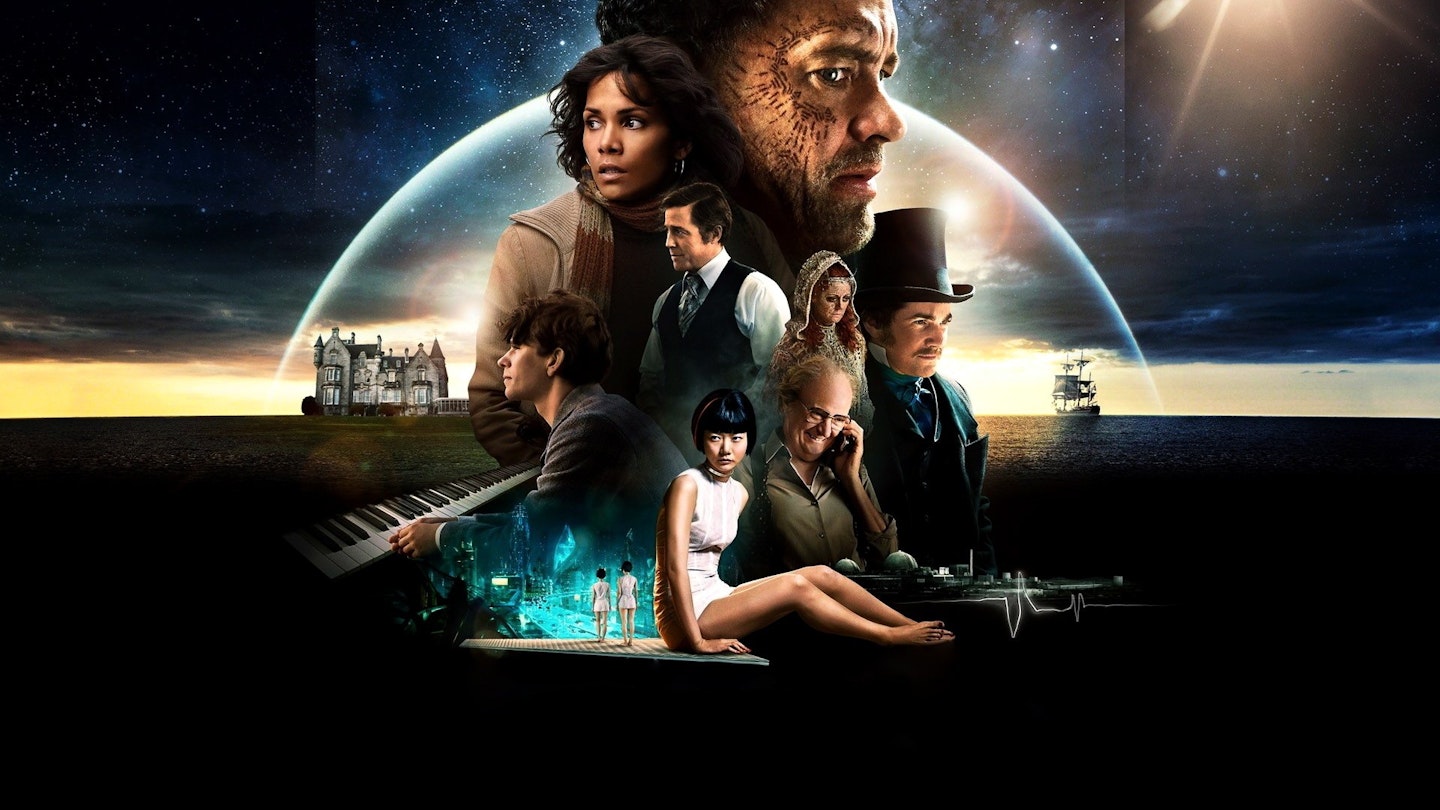Cinema’s first ever sci-fi-romance-thriller-historical-drama-with-a-bit-of-Ealing-comedy-in-it, it’s fair to say that Cloud Atlas is among the more daring movies of the year. Combining the Wachowskis’ vision and ambition with Tom Tykwer’s command of tone, texture and music, it is, as Empire’s four-star review puts it, “as magical, enthralling and thrilling as it is bewildering, pompous and potty”. Its interwoven structure of interlocking story threads skips vibrantly from the 19th century Pacific to future Neo-Seoul and beyond. These CG-enhanced worlds were created under the eye of VFX Supervisor Dan Glass, veteran of Tree Of Life, The Matrix and Batman Begins. With Cloud Atlas’s release on DVD and Blu-ray, the Method Studios man took us behind the curtain to explain how it was created.
A novel that, by even its writer’s admission, was “unfilmable”, Cloud Atlas is David Mitchell’s 554 page Booker-shortlisted tale of interconnected lives spanning time and geography. Before the adaptation was formally announced, Glass was one of the Wachowskis’ regular collaborators to be handed a copy.
Long in the planning, the movie began with a get-together in Berlin a year and a half before financing was locked in. Under the generalship of Lana and Andrew Wachowski and co-director Tom Tykwer, Team Cloud Atlas reunited long-term collaborators like Glass, VFXer on all Wachowski films since Matrix Reloaded, fellow visual effects supervisor Stephane Ceretti and storyboard artist Steve Skroce.
“I read the book before I realised that Lana and Andy Wachowski were adapting it. Sometimes they’ll just say, ‘Hey, you should probably read this’, and then you learn later, ‘Ah! It’s a script!’. There was a reading list for The Matrix movies with books that didn’t correspond directly to the films but that had the same philosophical undertones, like Jean Baudrillard’s Simulacra And Simulation. On Cloud Atlas, there was also [Paolo Bacigalupi’s biopunk science-fiction novel] The Windup Girl. We were well into making the film when I read that, but it described this rich world and had some beautiful ideas.
“We met for two weeks to just discuss ideas for how we could pull it off. It was pretty much decided as soon as we arrived that they wanted to do the film with two directorial teams handling three stories each, but that editorial and visual effects wouldn’t be split because our role would be to bring the movie together."
The effects work was divvied up between a dozen VFX houses, with Glass’s own Method Studios and Berlin-based RISE taking on the lion’s share of the work. The 500 effects shots planned proved to be a serious underestimate. There are some 1150 in the finished film.
“I’m proud that despite splitting across many companies, it all came together without feeling disjointed. As supervisor you’ve got all of these pieces coming in thick and fast and you’re constantly trying to guide them to make sure they feel similar. With Neo Seoul, we had four or five companies contributing to some of those vistas, with various artists creating [shots], so you’re constantly feeding what they’re doing to the others so it feels like the same city, as opposed to six different artistic views of it.”
The VFX pipeline was swollen, in part, with enhancements to the prosthetics of cast members. The face of Hugo Weaving’s Nurse Noakes, for instance, was bulked up with a prosthetic mask and had to be slimmed via the magic of visual effects. Call it the VFX diet.

“It was a natural collaboration on the prosthetics: [the make-up artists] agreed to take it so far and then we’d help do the rest. That’s the way that the Wachowskis work. They’re very creative and keep adding ideas as they go. With every one you’re going, ‘I don’t know how we’re gonna do it, but that’s pretty cool!’ Filmmaking is a tremendously collaborative process, unless you’re working for James Cameron or Chris Nolan. No disrespect at all to them as filmmakers, but they’re directors who drive the process very much from a point of view.”
The division of labour – the Wachowskis concentrated on the film’s 18th century and sci-fi threads, while Tykwer directed the pulpy ‘70s thriller and English-set segments – left Lana and Andy with the job of building an entirely original dystopian world to represent Neo Seoul in 2144 . And ‘entirely’, explains Glass, is the operative word.
“One of the challenges of working with the Wachowskis is that they want to reinvent everything. They’re not happy with transport systems that have been seen before. They try to reinvent every detail. They weren’t even happy with regular computer interfaces and monitors, so we had to reinvent that, as well as weapons fire and muzzle flashes. They don’t stop at anything.”
A multi-genre construction like Cloud Atlas gave the filmmakers the chance to raid their DVD shelves for handy touchpoints.
“Blade Runner was an conscious inspiration [for Neo Seoul], although we were trying not to imitate it too directly. But it was very helpful in gauging the way this city would feel. It had a similar core idea: that down in its darkest depths, the oldest parts of the city, is where the crime and social problems occur. It literally builds on top of itself as the sea levels rise. The Wachowskis love to create backstories that aren’t necessarily explained or visualized, but that help give the world a richness.”
Run by a fascistic corporate government – basically a weaponised ExxonMobile – Nea So Copros, aka ‘Neo Seoul’, has a rebellion fomenting. The cause of dissent, and fuel for the cause of freedom fighter Hae-Joo Chang (Jim Sturgess) and his precious charge Somni-451 (Doona Bae), is a vast disparity between rich and poor that had to be established in the design of the cityscape.
“Lana and Andrew had this idea that the city is under a constant, ominous threat, and the way that they wanted to stage that was by having the sea level constantly rising. There are these old dams holding back the vast weight of water from some parts of the city; in others, the water seeps in, laying them to waste, and those areas are the slum lands. We designed these ‘water villages’ that abut the remains of skyscrapers that poke out from the rising waters. People are lighting fires and living pretty basically, while on the other side of these walls you would have the towering, glittering spires of the wealthier inhabitants.”
Many of the cast were relative newcomers to the green screen work at Studio Babelsberg, but as Jim Sturgess told Empire, they took to it quickly. “Doona and I really got to know each other just from being stuck up there, talking bullshit,” he remembered. Glass and his VFX team were on hand to supervise the tech.
“[Green screen work] can be very difficult, but all actors are different. Some like to play off their environment; some are much more introverted in the way that they build their character, so it can vary a great deal but the big green-screen environment. It’s very strange, potentially intimidating even, unless there’s a clear understanding of what’s going on [in a sequence], so we always try to build pre-viz that we can show the actors. They can look at it and go, “Oh, okay. So when I look over there that’s what I see.” You try to help them get into the world as much as possible.
In Half-Lives: The First Luisa Rey Mystery, Halle Berry plays an investigative journalist who gets wind of a potential Three Mile Island-type disaster brewing at a nuclear power station. The Seaboard Corporation’s shonky Swannekke Lake nuclear power plant, across a road bridge from the mainland, was realised using CG and projected matte paintings.
“This bridge is just outside Glasgow and they used CG to represent the buildings. There’s some subtle matte painting in this shot and a lot of painting projected, in effect, onto some amazing 3D geometry, which enables you to manipulate the camera for different angles. Those old glass matte paintings were incredibly beautiful, but by their nature they couldn’t be animated and you couldn’t really manipulate the camera. We were able to break from that and shoot with a helicopter.”
While Method Studios worked on the Neo Seoul, VFX house RISE turned present-day Glasgow and Düsseldorf into 1975 San Francisco-area town Buenas Yerbas in the film.
“The original plan was to go to San Francisco to shoot this material - which obviously made sense! – but they couldn’t make it work financially, so we used Germany in part and Scotland. Steve McQueen’s Bullitt was an important reference for 1970s San Francisco.”
Luisa Rey’s pesky enquiries put her right in Seaboard Corp’s sights – note to readers: never upset an evil corporation – and culminate in an attempt on her life by hitman Bill Smoke. The bridge was actually nothing of the kind.
“Most of the exterior day scenes were shot in Glasgow, but the bridge at night was shot on a disused runway in Berlin. It has to look real and you have to put a lot of attention into detail and scale. A lot of it has to be still but you don’t want it to feel like a painting.”
*Painstaking pre-visualisation put together at Studio Babelsberg by the filmmakers and their VFX team established key shots in advance. In the case of Luisa Rey's Beetle plunge, practical and visual effects were married together with a gimbal and - ***cover your eyes, Herbie - *a sawn-in-half VW to reproduce the dynamics of the crash against green screen.
“Obviously there’s a conceptual phase, which can be reasonably quick, but then you go through lots of iterations. You can execute shots in a reasonably short period of time – a month, six weeks – but typically you end up spending longer on them because they’re such important pieces.”
Another key reference, this time for the Big Island section, came from Riddley Walker, a 1980 sci-fi novel by Russell Hoban. These sequences, in which Tom Hank’s tribesman Zachry and Halle Berry’s future bod Meronym join forces to evade the pilaging Kona cannibals, were shot in Mallorca.
“I never realised how mountainous and rocky Mallorca is. I thought it was a beach! There’s a barrenness to the landscape, especially at that time of year, which was extraordinary. I flew a lot on this film. I was also doing Tree Of Life’s Oscars bake-off at the time, so I was in Los Angeles, Spain, Germany… 30 times across the Atlantic altogether. Next, I’m flying to Chicago for six months on (the Wachowskis’ next project) Jupiter Ascending.”
Among the many perils Adam Ewing (Jim Sturgess) faces on his Pacific voyage – duplicity, poison, endless sauerkraut – are high seas and tempests. These apocalyptic weather systems were created by RISE by suppressing the Mediterranean sun of the location shoot and adding time lapse photography and 2D animation.
“Cloud Atlas is definitely less of an effects movie than, say, Life Of Pi, but it’s fantastic to have be a part of a movie that’s really trying to do something different – trying to test your intelligence. It feels much bigger than you.”
Cloud Atlas is out on Blu-ray and DVD now, from Warner Home Video
